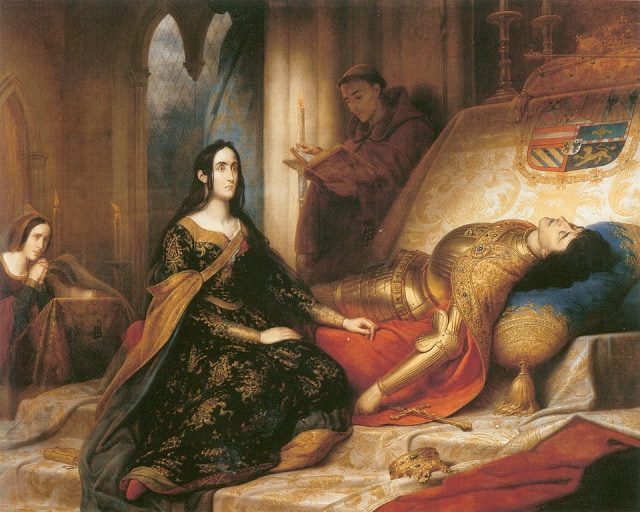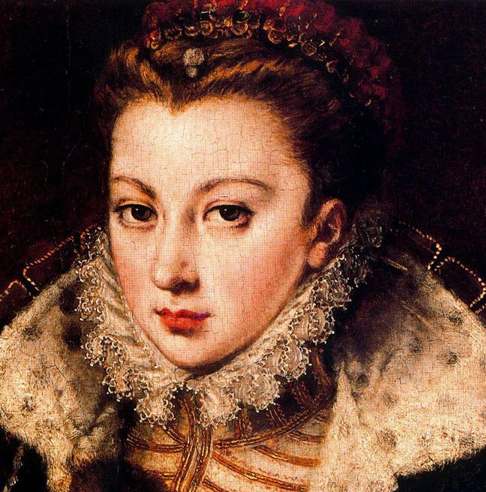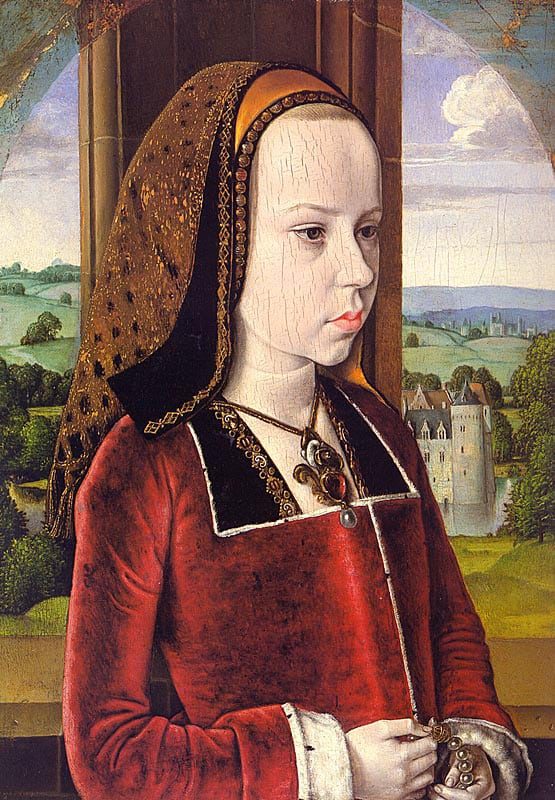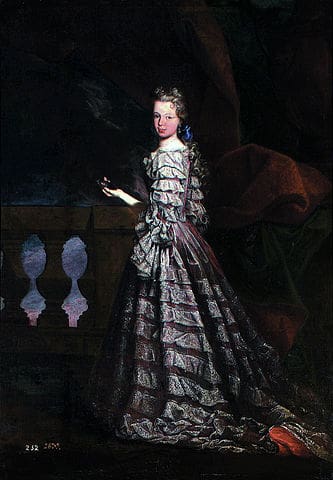The 15 Most Famous Spanish Queens
*Originally published by Molli in January 2020 and Updated by Vanessa on April 2023
Like most major European countries, Spain has seen some really impressive monarchs over the years! This includes several queens that have made their mark.
I love giving the spotlight to influential and important women in history, which is why I’m coming at you all with a list of my 15 personal favourite Spanish queens. Keep reading to learn more about these impressive women.
1. Queen Urraca of León
Queen Urraca of León was also known as Urraca the Reckless. She was Queen of León, Castile and Galicia, which were three separate Kingdoms within the Iberian Peninsula. This is the area that covers Spain and Portugal in modern times.
Urraca was the last surviving heir of Alfonso VI of León and his second wife Constance of Burgundy, giving her the right to reign over the Kingdoms of Castile and León. Well, one would think she had the right. In 1107, King Alfonso named his illegitimate son Sancho as the rightful heir, likely because he didn’t want a woman to rule.
Urraca was married off to a man named Raymond of Burgundy when she was just 8 years old. She had 2 children with Raymond before his death in 1107. Then, after her half-brother’s death in 1108, Urraca was named Queen. But, her father insisted that she marry again. He chose a man named Alfonso I of Aragon.
Urraca’s father died, but she honored his wishes by moving forward with her marriage to Alfonso of Aragon. Then, as more time went on, it became clear that the two were not a good match. Alfonso became abusive with Urraca and she left him.
Scholars and historians have noted that Urraca used her gender to her advantage in politics, and was able to secure the rights to the throne to her own heir. One historian in particular, Bernard F. Reilly, has written that, “There is no question that the queen is in control, perhaps all too much in control, of events.”
Reign as Queen of León, Castile and Galicia: 1109-1126
2. Isabella I of Castile
Isabella I of Castile is perhaps the most famous Spanish queen on my list! Through her marriage to Ferdinand II, she was able to unify Spain into one state. She also reorganised the government, lowered the crime rate in her country, and paid off all of the major debts that her brother had racked up before she took the throne.
Isabella and his husband are also famous for the exploration they commissioned during their rule. Their court supported the voyages of Christopher Columbus, and his discoveries helped to establish Spain as a global power.
While today we can recognize that the expansion of Spain across the globe also meant the colonization of native people in the “New World,” in those days it was a major power move for Spain. So, while I praise Isabella for lowering the crime rate and unifying Spain, I can’t say that I’m a huge fan of her exploration tactics.
Isabella was also a practicing Catholic, and she and her husband were given the right to add “The Catholic” to their names by Pope Alexander VI. After a process of canonization began in 1958, Isabella was given the title “Servant of God” by the Catholic Church in 1974.
Reign as Queen of Castile and León: 1474-1504
3. Joanna of Castile
Joanna of Castile was the daughter of Isabella I of Castile and Ferdinand II of Aragon. When Queen Isabella I died in 1504, Joanna became Queen of Castile, and her father called himself “Governor and Administrator of Castile.”
Joanna was technically queen, but she played almost no role at all in the government. She was determined to be insane and was swiftly imprisoned by order of her father. He subsequently ruled as regent until he too died in 1516. Joanna then inherited his kingdom, and was crowned Queen of Aragon as well.
Joanna was co-monarch alongside her son Charles I, but she remained imprisoned for her entire life. She was sometimes referred to as Joanna the Mad, but most historians say that she probably was suffering from depression.
Reign as Queen of Castile and León: 1504-1555
Reign as Queen of Aragon: 1516-1555
4. Isabella of Portugal
Isabella of Portugal was not only Queen consort of Spain, she was also Holy Roman Empress and Queen of Germany, Italy, Naples and Sicily and Duchess of Burgundy. That’s a lot of titles! She gained the Duchess of Burgundy title through her husband, Emperor Charles V.
Isabella of Portugal’s grandparents were Isabella I of Castile and Ferdinand II. She is often compared to her grandmother for her beauty and skill in politics! Isabella played a huge role in Spanish politics at the time as her husband was often away traveling.
She was also known as a loving mother who focused on giving her children the best education out there. Unfortunately, Isabella suffered from weak health, and was often ill with malaria! She died at just 35 years old.
Reign as Queen consort of Spain: 1526-1539
5. Elisabeth of Valois
Elisabeth of Valois was French, the daughter of King Henri II of France and Catherine de’ Medici. She married the king of Spain, Philip II when she was only 14 years old, but despite the massive age different between herself and the king, the couple seems to have been in love.
Elisabeth was a patron of the arts and brought in two Spanish painters to live with her after she was married. She also enjoyed painting herself, and took lessons from her artist friends!
At 23, Elisabeth died in childbirth. Her mother, Catherine, suggested that Philip marry another one of her daughters, but he was so devastated by the death of Elisabeth that he declined.
Reign as Queen consort of Spain: 1559-1568
6. Margaret of Austria
Margaret of Austria became Queen consort of Spain and Portugal through her marriage to Philip III and II. Her husband has both Philip III and II due to his titles in Spain as well as in Italy.
Margaret sounds like exactly my kind of queen, due to her involvement in government and politics. Historians say that she had a lot of influence over the king, and even banned together with a group of women to urge him on certain policies.
She had strong ties with her Catholic faith, and often worked on bringing Catholicism to Europe.
Reign as Queen consort of Spain and Portugal: 1599-1611
7. Mariana of Austria
Mariana of Austria married her uncle Philip IV (incest was normal back then! Yuck) and became Queen of Spain in 1649. After her husband/uncle’s death in 1665, she served as regent to her son Charles II due to his weak health. Serving as regent means that Mariana acted as monarch in place of her son.
When she was Queen, Mariana was pushed out of politics due to her gender. So, she decided to focus on education and religion in Spain.
Probably due to all of the incest, Mariana’s son Charles was disabled, which is why she served as his regent. You may recognize her daughter, Margaret Theresa, from the famous Velasquez painting Las Meninas!
Reign as Queen consort of Spain: 1649-1665
8. Marie Louise d’Orléans
Marie Louise d’Orléans was born in Paris and was the granddaughter to the king of France. She was married to Charles II, King of Spain as a way to bring peace to the fighting countries.
Marie Louise lived a fairly lonely life in Spain, as her husband suffered from physical disabilities and was often very ill. She was also often stressed out and anxious as she could not get pregnant. Scholars say that Charles II was in love with Marie Louise and they tried to produce an heir, but nothing came to fruition.
The Queen consort was riding on horseback one day when she felt a severe pain in her stomach. She died the next night. There are some that think she was poisoned because she had failed to produce an heir! This was never confirmed or denied, so this one will go down as a mystery!
Reign as Queen consort of Spain: 1679-1689
9. Maria Luisa of Savoy
Maria Luisa of Savoy married Philip V of Spain and became the Queen consort of Spain in 1701. The pair were both French, and Philip V had been named king of Spain after Charles II died without any heirs.
Philip V was madly in love with Maria Luisa, and she had a huge influence on the Spanish government. Historians write that she was smart, mature and had a mind for politics. Philip was known for being a little bit wishy-washy, and Maria Luisa played a big role in focusing the king.
Philip V left Spain to fight in Italy in 1702, and Maria acted as regent until he returned in 1703. She was only 14 at the time, but historic documents show that she made several improvements in Spain during her time as regent.
Reign as Queen consort of Spain: 1701-1714
10. Isabella II
Isabella II was crowned Queen when she was only 3 years old. Her mother, Maria Christina served as regent until Isabella II turned 16. She was then forced into a marriage with her cousin, Francisco de Asís de Borbón.
She was known to be involved in politics, and during her reign Spain fought two wars. When Spain lost at the Battle of Alcolea in 1868, Isabella II was exiled to France. Her exile played a part in the Franco-Prussian War, as Napoleon III did not want a Prussian ruler to take the crown in Spain.
Isabella lived in Paris until she died in 1904.
Reign as Queen of Spain: 1833-1868
11. Victoria Eugenie of Battenberg
Princess Victoria Eugenie, a granddaughter of Queen Victoria, was the only child of Prince Henry of Battenburg and Princess Beatrice. During his service in South Africa in 1896, her father passed away from fever. In 1906, she tied the knot with Spain’s King Alfonso XIII. Princess Victoria came dangerously close to being assassinated by the bomb during the assassination attempt on her way back from the wedding ceremony.
The eldest and youngest boys of the royal couple’s seven offspring, both of whom were carriers of the haemophilia Queen Victoria Eugenie had, inherited the disease. The Spanish royal family fled to France and then Italy in 1931 following unfriendly elections that resulted in the creation of a republic. King Alfonso abdicated in favour of his son during this time after the marriage divorced.
12. Letizia Ortiz
There’s a good possibility you’ve heard of Queen Letizia of Spain if you’re familiar with Princess Charlene, Princess Caroline, and the royal princesses of Sweden. or maybe you vaguely recall that she used to be a journalist. She is not as popular as royal heavyweights like Kate Middleton but she is the Queen of Spain.
Spain’s current queen consort is Letizia Ortiz. She was a journalist and news anchor before getting married to King Felipe VI in 2004. She was born in Oviedo, Spain, in 1972. What does she do? She performs formal tasks and represents the Spanish monarchy both at home and abroad in her capacity as queen consort. She is known for her grace, wit, and dedication to a number of social concerns, such as health, culture, and education. Letizia is the first Spanish queen consort who was born to a lower-class family.
13. Leonor of Castile
King Henry III was married to Lenor of Castille (1202–1244) who was queen consort of England. Her parents were Eleanor of England and King Alfonso VIII of Castile. As a queen, she was known for her devotion and brilliance and she took on the job of regent when her husband was not around.
Eleanor was taken to France for safety when Henry III’s baronial rivals took control of England in 1264; she arrived back in October 1265 after Edward had put an end to the rebellion. In the years 1270–1273, Eleanor travelled with Edward on a crusade. At each stop her coffin made on the route to London after her death, Edward erected the renowned Eleanor Crosses, some of which are still visible today.
14. Constance of Aragon
King Emeric of Hungary was married to Constance of Aragon (1179–1222), who served as Hungary’s queen consort. The king of Aragon, Alfonso II, and his Castilian bride, Sancha, were her parents. Constance was considered one of the most educated women of her day and was well-recognised for both her beauty and intelligence.
Constance of Aragon was the first Hungarian queen to have her image appear on coins during her reign, which is an interesting fact about her. One of the earliest known representations of a European queen on a coin dates to 1205, when she was shown on a denarius struck in Esztergom.
15. Blanche II of Navarre
King John II of Aragon was married to Blanche II of Navarre (1424–1464), a queen consort of Aragon, Sicily, and Naples. Her parents were Blanche I of Navarre and King John II of Navarre. Navarre has been described as stunning and was known to participate in governmental affairs where she offered advice to the king.
In addition to her political skills, she acted gracefully like a queen and was refined, she has interests in poetry and music. As a mother, she had 4 children who she had with her husband John II, one of her children was King Ferdinand of Aragon. Blanche II did not let her son’s throne slip away and she ensured that her son’s succession after her husband’s death went smoothly.
Conclusion
I hope you’ve all discovered more on some of the most famous Spanish queens! These 10 important women played large roles in the Spanish monarchy over the centuries, and I’ve really enjoyed telling you all about them.
If you want to learn more about Spanish history, why not join one of our walking tours in Barcelona? Our local guides really know their stuff, and you’re sure to learn a little thing or two from them! Click here to learn more and make your booking.
Planning a trip to Paris ? Get ready !
These are Amazon’s best-selling travel products that you may need for coming to Paris.
Bookstore
- The best travel book : Rick Steves – Paris 2023 – Learn more here
- Fodor’s Paris 2024 – Learn more here
Travel Gear
- Venture Pal Lightweight Backpack – Learn more here
- Samsonite Winfield 2 28″ Luggage – Learn more here
- Swig Savvy’s Stainless Steel Insulated Water Bottle – Learn more here
Check Amazon’s best-seller list for the most popular travel accessories. We sometimes read this list just to find out what new travel products people are buying.




















